|
|
FROM THE DREAMS TO NOWADAYS
1
- Dream of Ícaro
Since immemorial times the man dreams in flying. To possess the capacity of raising flight and getting loose themselves of the ground, as the birds, meant the freedom, the meeting with vastness without borders and to reach the transcendency of its limitations, in all the old civilizations.
|
DEDALUS AND ICARUS
Dedalus was a clever and rich Athenian sculptor who, because of intrigues and the envies in its native city, fell ahead in disaster of the king, ad so he was in the misery and finally was banished from Athenas . He was taken refuge in Crete with his son Icarus, where he counted on the admiration of king Minus until he pitied the queen because of the terrible revenge of Zeus and protected the son of her, the Minotaurus , constructing to him a palace, the Labyrinth of Cnossus, what went against the sovereign’s orders.
Needing to run away from Crete, Dedalus ordered its son to collect all the feathers of birds that he could and so , he glued them one to one on a base, and constructed two pairs of wings. In the date of the flight he recommended Icarus to not fly very high. But this, in the ecstasy of youth and the enthusiasm of the magnificent fact, was forgotten the recommendation and the solar rays had melted the wax and the feathers had fallen one to one, making to precipitate him in the Aegean Sea.
Dedalus obtained to arrive at his destination and lived much time, always with the immense pain of the loss of his beloved son, whose body later was found in an island, that currently takes his name - Icara.
Icarus was consecrated as a symbol of that ones who glorify himself to die for the conquest of the space.
|
2
- Precursors
 |
| 1060 Till 1897
|
| 1060 |
English benedictine monk Oliver tries to fly with cloth wing and jumps of a monastery. He breaks arms and legs in the attempt. |
| Centuries
XV |
Leonardo da Vinci draws the "aerial screw", an impracticable, but bold technical project in the inspiration. |
| 1709
|
Brazilian priest Bartholomeu de Gusmão raises the 4 meters of height a small balloon of paper inflated with hot air. The fact was witnessed by king Dom João V and his court, in Lisbon. |
| 1783 |
French brothers Montgolfler raise a balloon the 300 meters of height. The balloon was manned by a duck, a rooster and a sheep. Months later the Marquis d'Arlandes and Pilatre de Rozier became the first human being to fly , manning a balloon of the Montgolfier per 25 minutes. |
| 1804 |
English George Cayley establishes basic concepts for the beginning of aviation when launching a glider not manned, the first flying device more weighed than air. In 1853 he makes a manned test. |
| 1891 |
German Otto Lilienthal invents the precursor of the delta wings. He obtains to glide shooting himself of the high one of a hill with his invent. Lilienthal makes a thousand flights more than, but he dies in 1896 in a unsuccessful maneuver. |
| 1897
|
Santos Dumont constructed the first efficient explosion engine of the aeronautics. The engine of two cylinders was used in his first airships. |
|
3
- AIRSHIPS
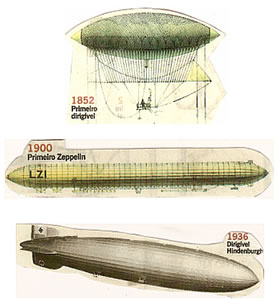 |
| CENTURIES
XIX and XX
|
| 1898
|
Santos Dumont makes his first balloon, the Brazil, and also his first airship. |
| 1900 |
The Count Zeppelin invents the airships that take its name. |
| 1901 |
Santos Dumont gains the Deutsch prize when skirting the Eiffel Tower in 30 minutes. He proved to be possible to control the direction of an aircraft. |
| 1903 |
The Cuban Aida d'Acosta becomes the first woman to pilot an aircraft. She pilots the airship nº 9 of Dumont. |
| 1929
|
The airship Graf Zeppelin becomes the first flying device to give the return to the world.
|
|
Much influence exerted the aviation, just-inaugurated in the beginning of century XX, as much on the of functions of peace how much on the ones of war. In the first case, we find the development of the services of delivery of correspondences and communications the long distance, the tourism, the cultural interchange and commercial and in the second, the enlargement of the military power and the sectorial and world-wide conflicts, with the transport of new and powerful weapons.
The great hero of literature relative to aviation is, without any doubt, the Frenchman Antoine de Saint-Éxupery, born in Lyon in 1900. He received international recognition in life and awardings for his magnificent works and thes are the most noted : "Post office of the South" (1929), "Flight of the Night" (1931), "Land of the Men" (1939), "War pilot" (1942), "The Litlle Prince" (1943), "Letter to a Hostage" (1943); after his death, it was found and published the book "Fortress". He was military pilot and aviator of the Air mail Toulouse/Casablanca, Dakar/Casablanca, and come to die in 1944, when he was flying over the English Channel in mission – his airplane was seen falling down to the sea in flames. Without a doubt, tragic similarity to the end of Icarus.
4
– FIRST FLIGHTS
 |
THE BEGINNING Of CENTURY XX
|
| 1903 |
The American brothers Wilbur and Orville Wright announce to have done a descending flight with a device incapable to take off. |
| 1906 |
In October, 23rd , Santos Dumont gains the prize Ernest Achdeacon with the 14 bis to being the first to realize a flight of 25 meters withd a device more weighed than the air that settled and took off for their proper ways. In November, 12th he makes the first homologated mechanical flight of the History, that followed the criteria of the International Aeronautical Federacy. He covers with the 14 Bis two hundred meters, the six meters of height, in 21 seconds, to an average speed of 37,4 km/h. |
| 1907 |
Santos Dumont invents the Demoiselle, the first airplane monoplane, an ultralight one. The model was perfected in 1909. It was done of bamboo, metal and silk and weighed 115 kilos. In this exactly year, the Frenchman Paul Cornu invents the helicopter. |
| 1908 |
The Frenchman Louis Blériot obtains to cross the English Channel. |
| 1911 |
It shows up the first hydroplane, created by the American Glenn Curtiss.. |
| 1922 |
The Portuguese Gago Coutinho and Sacadura Cabral make the first passage of the South Atlantic, between Lisbon and Rio De Janeiro. |
| 1927 |
The American Charles Lindbergh flies from New York to Paris without stops for restocking and rest. |
|
5
- HELICOPTER
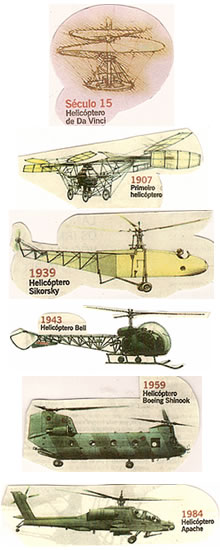 |
FROM DA VINCI TO NOWDAYS
|
| Centuries
XV |
Leonardo da Vinci, extraordinary genius of the Reaissance, multipurpose, excellent engineer, made two sketches of machines to fly. The first one, the “aerial screw”, is considered the precursor of the helicopter – although not to posesss helix, but a superior sail in screw form, already it presented the plan for the vertical take-off. Experiences had been made modernly, but it did not demonstrate capacity to fly.
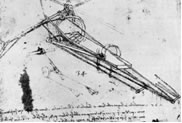 Another invent that Da Vinci tested on January, the third, was the “flying machine”, but it had failure – although the experience of hte brilliant inventor have had unsuccessful, the idea of the superior blades and the form of the object remind of the current helicopters (see above).
Another invent that Da Vinci tested on January, the third, was the “flying machine”, but it had failure – although the experience of hte brilliant inventor have had unsuccessful, the idea of the superior blades and the form of the object remind of the current helicopters (see above). |
| 1907 |
In this year the Frenchman Paul Cornu, a manufacturer of bicycles in Lysieux, France, invents the helicopter, using two wheel of cicycles to move 4 shovels, divided in two pairs in each one of the wheels.
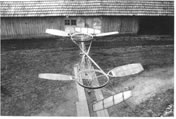
The same year, yet, he constructs his original model, perfectioning of that first matrix that raised flight, being, still of this time, the first man in the invention. |
| 1939 |
|
| 1945 |
|
| 1959
and 1984 |
These are war hlicopters. The first is used for transport soldiers and parachutists , and the opther, for recognition and combat. As we can see, the idea of Cornu about two propeller helix is well used to advantage.. |
|
6
- BALLOONS
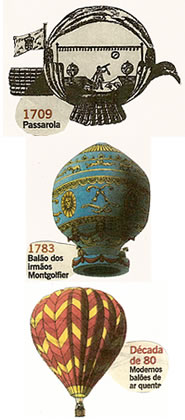 |
FROM THE ANTIQUITY TO NOWADAYS
Since the Antiquity it was custom for the Orientals of the Chinese region to raise balloons moved by heat , however for competitions, festivals, however in homage the celestial entities, always with the dream of transcendêency of our own condition of biped imprisoned to the soil of our beloved planet. From there the habit came to the Ocident, serving later for the transport of people - currently they are common in sportive and scientific activities or of work and some of them fly higher than airplanes. .
|
| 1709 |
Brazilian priest Bartholomeu de Gusmão raises the 4 meters of height a small balloon of paper inflated with hot air. The fact was witnessed by king Dom João V and his court , in Lisbon. |
| 1783 |
French brothers Montgolfier raise a balloon the 300 meters of height. The balloon was manned by a duck, a rooster and a mutton . Months later, the Marquis d'Arlandes and Pilatre de Rozier become the first human beings to fly, manning a balloon of the Montgolfier per 25 minutes. |
| 1898 |
Santos Dumont makes its first balloon, Brazil.
|
| 1990 |
The decade of 90 attends a revolution in the manufacture of balloons. Some of them arrive to fly higher than airplanes. |
|
7
– WAR AIRCRAFTS
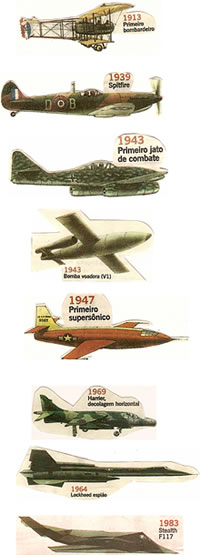 |
|
The TWO WORLD-wide WARS
As well as some inventions, the airplanes, in the beginning, had pacific purposes, but, with the time, they became powerful instruments of war.Santos Dumont had become attended this horrified. Since during the Fist Great War of century XX, that initiated in 1914 and finished in 1918, airplanes had been used, at the beginning as assistant in the recognition and, later, as machines of war, with detached pilots of the RAF - Real Air Force, England, and, from Germany, the squadron of huntings Jagdstaffel or Jasta II, being the most famous for courage and ability, recognized as true hero even for the enemies, the feared Baron Manfred Von Richthofen, nicknamed "Red Baron" because his airplane, an Albatroz D II, biplane of the Foker, was paint of red :

In Brazil, in 1914 it was created the first Brazilian School of Aviation , whose headquarters were in Fields of the Afonsos , in Rio De Janeiro - closed during the First World-wide War, it was reopened in 1918, under the direction of the Ministries of the War, today of the Army and the Navy.
|
| 1914
the 1918 |
The airplanes are used as weapons and already in 1917 there was a small factory in Wiesbaden and another one in Berlin, both in Germany. In the end of the first world-wide conflict there were more than 180 thousand airplanes produced in the world and some of them were capable to reach 220 km/h.
|
| 1939 |
The Second World War stimulates the aerial industry and appears the first efficient spurts (the tecnology is of years 20). The Germans launch the autopropelller bombs V1 and V2. |
| 1983
|
The Americans launch their first invisible airplane, the F-117 the Steal. |
|
8
– COMMERCIAL AIRCRAFT
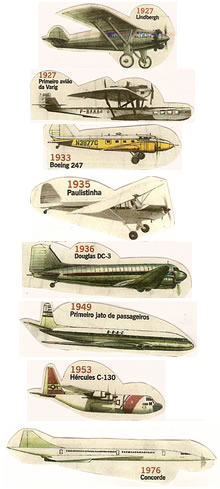 |
|
FROM THE PASSAGE OF ATLANTIC
TO NOWADAYS |
| 1922 |
The portuguese Gago Coutinho and Sacadura Cabral make the first passage of the South Atlantic, between Lisbon and Rio De Janeiro. |
| 1927 |
The American Charles Lindbergh flies from New York to Paris without stops for restocking and rest. In this exactly year is established the Varig. . |
| 1933 |
The American Boeing launches the 247, the first modern liner airplane. |
| 1935 |
Enrique Lage establish the National Company of Air travel to produce airplanes in commercial scale in Brazil . Its more famous model was CAP 4, the Paulistinha. |
| 1938 |
It was created Douglas DC3, the first one of a generation that could offer to profit and security. . |
| 1948
|
The civil aviation, at the time of the Cold War, has a great advance. Passengers jet plantes as the Comet, of 1949, reduce the trip time |
| 1964 |
Launched the Intelsat, the first commercial satellite of telecommunications and the Syncom 3, the first geostationary satellite of success. |
| 1969 |
In Brazil is established the EMBRAER. Its first airplane is the Bandeirantes. Boeing launches 747, the capable one to carry 400 passengers. |
| 1976 |
France and Great-Britain launch the Concorde, the first supersonic airplane of passengers, capable to cross the North Atlantic in less than three hours. It was removed of activity in 2003 because the racket of retraction of its motor when it reached the speed of the sound. There was very great uproar that affected enormous areas for where it passed. It does not have commercial supersonic anymore on that size.
|
| 2006 |
EMBRAER enters the manufacture of more than 3,600 airplanes. |
|
From the dream of Dedalus and Icaro until century XX, when the man dominated the art to fly for the atmosphere of the Earth and was beyond, until the stratosphere, and finally to the infinite space that separates it of the other planets, other galaxies, much time has passed on. The fights have had been too many, our great friend and companion, the dog, preceded the man, impersonatied for the unforgetible Laika, died in sideral space.
 |
Today we live in our beloved blue home , separated one anothers for borders of some sovereignties, some languages, some religions, some etnich groups, some chains of thought, some economies. But our representatives, when they sail in a spaceship or they remain in the International Station in orbit of the Erth, they become brotherhood branches of a great tree with roots thrusted on the bow of affinity that joins all men and erases all the differences: to be part of Humanity. Quiçás this understanding would make us, some day, and that it is brief, to find the peace of that as much we need to continue the long walking in search of new dreams, of new realities. |
|
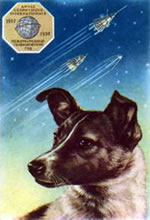 |
9
- SPACE AIRCRAFTS
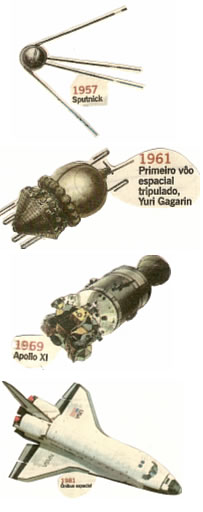 |
| FINALLY the SIDEREAL SPACE
|
| 1946 |
The Cold War gives beginning to the space race. Among airplanes of the period, are distinguished the Americans B-52 and LockheadC-130. In 1947 the airplane-rocket Bell X-1 breaches the barrier of the sound. |
| 1957
|
The Russian rocket R-7 places in orbit the first artificial satellite of the world, the Sputinik, a sphere of 50 cm and 83 kg. |
| 1961 |
The Russian Yuri Gagárin becomes the first man to go to the space, in 12 of April. "the Earth is blue", says on board Vostok I. Its flight lasted 108 minutes. |
| 1964 |
Launching of the Intelsat, the first commercial satellite of telecommunications, and Syncom 3, the first geostationary satellite of success. |
| 1969 |
On July, the 20th the commander of Apollo 11, Neil Armstrong, becomes the first man to step on in the Moon . He and Buzz Aldrin had walked for the satellite and had left scientific instruments there.
|
| 1981 |
NASA launches the first space bus, the Columbia. The American space agency arrived to construct a fleet of five bus. The program, however, was marked by the tragedies of the Challenger, in 1986, and of the Columbia, in 2003. The space buses are considered the most complex machines already constructed by the man and have millions of parts.
|
| 2006 |
April , the 29th , 2006, to the 23:30 h., hour of Brasilia, Marcos Pontes, the first Brazilian cosmonaut, in the Baikonur airbase, the Kazakhstan , is launched to the space on board the Russian spaceship SOYUZ Tma-8 route to International Spacial Station (ISS). and , at this moment he is in orbit of the Earth, inside the station . He will be doing there botanic scientific experiences and he will give a class on that subject to children, in Brazil, about the growing up of plants in ambient without terrestrial atmospere , as it is programmed.

|
|
10
- AIRCRAFT AND FUTURE :
DO WE WILL OBTAIN TO MOUNT THIS PUZZLE?
FROM THE CENTURY XXI ON
It is undisputed our technological advance. It is foreseen discovered of new fuel forms capable to lead our spaceships through the space so that let us can reach new routes in our dreams, now more confident on our capacity to fight and to be successful.
We live a similar time to that one of the Great Navigations. As our European ancestors, our heroes donate their lives and tame horizons for us. And as they thought at those times, we also do today’s : most people don’t believe that it exists other peoples st, other races, other cultures, other realities out of the context of the surface of the Earth. Many scholars of old times hat time did not believe the positive hypothesis. The old ones had obtained to discover the reply to these questions. Let us wait that also we will obtain to get ours.
There is a great question that we cannot make silent, because the answer is essential for not committing the same errors that the old occidental civilizations had carried through in the New World: we already possess technique enough to arrive at new lands, to the new planets, but, will we already morally mature enough to establish a healthful conviviality with all the surprises that perhaps we come to find in our great trips route the new discoveries?
SOURCES :
Book :La Legenda de Icaro, de Robert Ludlum, 1988, Ed. Javier Vergara
Illustrations : files of IEJU-SA and special notebook of newspaper “ O Globo” – Santos Dumont, de 25.3.2006
Historic Facts : files of IEJU-SA and special notebook of newspaper “O Globo” – Santos Dumont, de 25.3.2006
See more :
http://www.pioneirosdoar.com.br/pioneiros/sexupery.htm
www.terra.com.br/voltaire/seculo/2002/11/11/003.htm-25k
www.defesanet.com.br/rv/history/wwwl_aces.htm-60k
www.tg3.com.br/1gm/6k
www.historianet.com.br/conteudo/default.aspx?codigo=284-11k- |
|
|